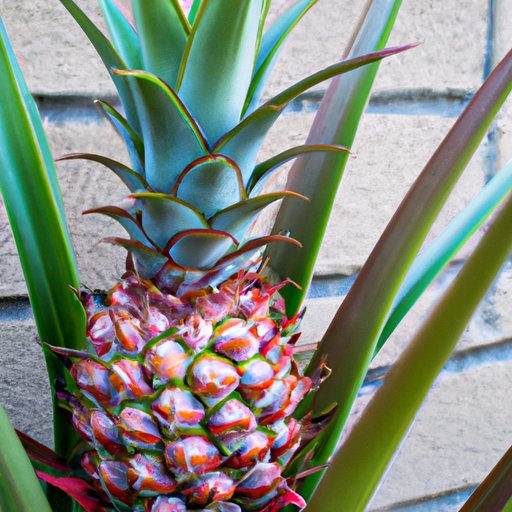Introduction
Growing a pineapple top is not only a fun and eco-friendly gardening technique but also a great way to enhance your indoor or outdoor space with a tropical plant. Pineapples are easy to grow, and their sweet taste and numerous health benefits make them a desirable fruit to add to your diet. In this article, we will provide step-by-step instructions on how to grow a pineapple top and discuss the benefits of regrowing one.
Step-by-Step Instructions
The first step in growing a pineapple top is to remove the top of a fresh pineapple with sharp pruning shears. Look for a top with healthy green leaves and remove any excess flesh, leaving about an inch of fruit on the base of the leaves. Then, allow the top to dry for one to two days, until the cut end has a calloused appearance.
Next, fill a pot with well-draining soil, leaving a couple of inches of space at the top. Make a small hole in the soil, place the pineapple top inside, and gently press down until the soil is level with the base of the leaves. Water the soil lightly, making sure the soil is moist but not waterlogged.
Soil
Pineapple tops thrive in well-draining soils with a slightly acidic pH level between 4.5 to 6.5. You can use a combination of sand, perlite, and peat moss to create a light, airy mixture. Alternatively, you can opt for a high-quality potting soil that is specifically formulated for container gardening.
To prepare the soil for planting, mix the soil with sand or perlite to improve drainage. If you choose to use a pre-mixed soil, ensure that it is loose and well-draining.
Light and Temperature
Pineapple tops require bright sunlight to grow properly, so place your potted plant near a window that receives at least six hours of direct sunlight each day. If you don’t have access to bright light, artificial grow lights can provide supplemental lighting.
Pineapple tops prefer warm temperatures between 60°F and 80°F, so keep the plant in a room that stays within that temperature range. During the winter, you may need to provide additional warmth through a space heater or by placing the plant near a heat source, such as a radiator.
Watering and Fertilizing
Pineapple tops require moderate watering, so water the plant when the top inch of soil feels dry to the touch. Ensure that the soil is moist but not waterlogged, as overwatering can lead to root rot and other fungal diseases.
You should fertilize your pineapple top every two to three months during the growing season. Use a fertilizer that is high in potassium and phosphorus, as these nutrients promote healthy fruit production. You can also use a slow-release fertilizer to provide a steady supply of nutrients over time.
Troubleshooting
Pineapple tops are generally easy to grow, but they can be susceptible to pests and diseases like mealybugs, spider mites, and root rot. If you notice pests on your plant, remove them by spraying the pineapple top with a mixture of water and a mild soap. To prevent pests from returning, keep the plant clean, and avoid overwatering and overcrowding.
If you notice signs of root rot, such as wilting, yellowing, or drooping leaves, stop watering immediately and allow the soil to dry out. You may need to repot the plant in fresh soil to get rid of any fungal spores.
Conclusion
Growing a pineapple top is a fun and easy way to add a tropical plant to your indoor or outdoor space. Follow our step-by-step instructions to get started, and enjoy the many benefits of regrowing your own pineapple plant. With proper care and attention, you can grow a healthy and delicious fruit that will impress your friends and family.
